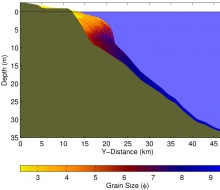Clinoform 2008: Difference between revisions
(New page: ===Clinoform sedimentary deposits: The processes producing them and the stratigraphy defining them, Aug. 15 - 18, 2008=== {| | width="380px"|'''Date:''' August 15 to 18, 2008 | align="l...) |
|||
| Line 2: | Line 2: | ||
{| | {| | ||
| width="380px"|'''Date:''' August 15 to 18, 2008 | | width="380px"|'''Date:''' August 15 to 18, 2008 | ||
| align="left" rowspan=5 |[[image: | | align="left" rowspan=5 |[[image:No_xshore_currents_grain.jpg|220px]] | ||
|- | |- | ||
| '''Location:''' | | '''Location:''' Western Wyoming Community College, Rock Springs, WY, USA | ||
|- | |- | ||
| '''Host:''' | | '''Host:''' SEPM | ||
|- | |- | ||
| | | | ||
| Line 18: | Line 18: | ||
| | | | ||
|} | |} | ||
''' | '''Convenors:'''<br> R. Steel (Univ. of Texas): [mailto:rsteel@mail.utexas.edu rsteel@mail.utexas.edu]<br>C. Nittrouer (Univ. of Washington): [nittroue@ocean.washington.edu nittroue@ocean.washington.edu] | ||
''' | '''Sponsors:'''<br> | ||
SEPM<br> | |||
CSDMS | |||
''' | '''Introduction:'''<br> | ||
We aim to bring together the "modern, ancient and modeling" communities who have an interest in clinoform deposits, specifically in their formation, character and significance. The focus will be on clinoforms found on continental shelves, in association with fluvial-deltaic systems, including the deeper water shelf margin itself. Whereas the modern community focuses on formative processes and spatial variability of clinoforms, the ancient community has data and insight on sedimentary facies and development over longer time scales. The modelers (numerical and physical) are critical to both groups for providing links between time scales. In turn, the modelers seek validation for the results of their models. All three groups are interested in the source-to-sink aspects of shelf-scale clinoforms. A field Conference will allow prolonged dialog and discussion, while examining some classic field examples of river-, tide- and wave-dominated deltas on shelf and shelf-margin settings. <br> | |||
''' | '''Conference themes:'''<br> | ||
# | # Scale independence of clinoform morphology | ||
# | # Linkages between deltaic and subaqueous shelf deposits? | ||
# Margin morphology and shelf-edge deltas | |||
# Tide-, wave- and river-dominated deltas and relationships to clinoform structure | |||
# Subaerial and subaqueous portions of deltas - their formative relationships | |||
# Sandy and muddy gravity flows distributing sediment on clinoforms | |||
# Along-clinoform heterogeneity of structure and the processes responsible | |||
# Cross-shelf clinoform migration with changing sea level and supply | |||
''' | '''Conference fees:'''<br> | ||
Registration fee for 4-day conference will be announced shortly. This will include field transport, abstract book, field-guide books, lunches during two field days, drinks during two field days and meals during lecture days at WWCC. | |||
'''First | '''First circular:'''<br> | ||
[[media:|Download here]] the 1st circular for the meeting. | |||
Revision as of 17:00, 5 March 2008
Clinoform sedimentary deposits: The processes producing them and the stratigraphy defining them, Aug. 15 - 18, 2008
| Date: August 15 to 18, 2008 | 
|
| Location: Western Wyoming Community College, Rock Springs, WY, USA | |
| Host: SEPM | |
Convenors:
R. Steel (Univ. of Texas): rsteel@mail.utexas.edu
C. Nittrouer (Univ. of Washington): [nittroue@ocean.washington.edu nittroue@ocean.washington.edu]
Sponsors:
SEPM
CSDMS
Introduction:
We aim to bring together the "modern, ancient and modeling" communities who have an interest in clinoform deposits, specifically in their formation, character and significance. The focus will be on clinoforms found on continental shelves, in association with fluvial-deltaic systems, including the deeper water shelf margin itself. Whereas the modern community focuses on formative processes and spatial variability of clinoforms, the ancient community has data and insight on sedimentary facies and development over longer time scales. The modelers (numerical and physical) are critical to both groups for providing links between time scales. In turn, the modelers seek validation for the results of their models. All three groups are interested in the source-to-sink aspects of shelf-scale clinoforms. A field Conference will allow prolonged dialog and discussion, while examining some classic field examples of river-, tide- and wave-dominated deltas on shelf and shelf-margin settings.
Conference themes:
- Scale independence of clinoform morphology
- Linkages between deltaic and subaqueous shelf deposits?
- Margin morphology and shelf-edge deltas
- Tide-, wave- and river-dominated deltas and relationships to clinoform structure
- Subaerial and subaqueous portions of deltas - their formative relationships
- Sandy and muddy gravity flows distributing sediment on clinoforms
- Along-clinoform heterogeneity of structure and the processes responsible
- Cross-shelf clinoform migration with changing sea level and supply
Conference fees:
Registration fee for 4-day conference will be announced shortly. This will include field transport, abstract book, field-guide books, lunches during two field days, drinks during two field days and meals during lecture days at WWCC.
First circular:
[[media:|Download here]] the 1st circular for the meeting.
